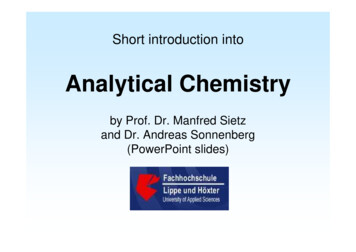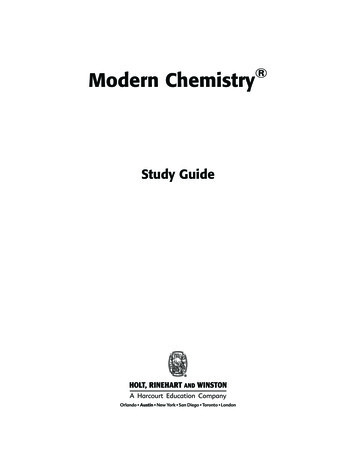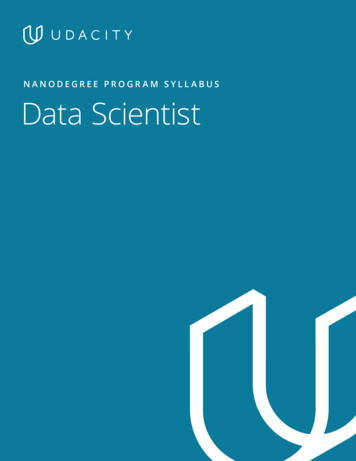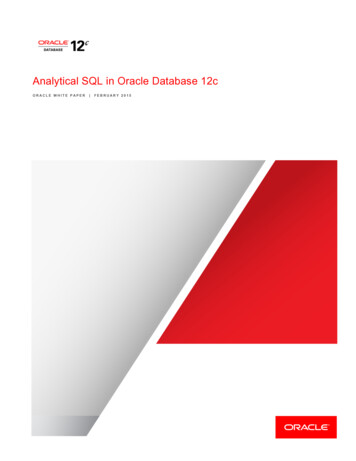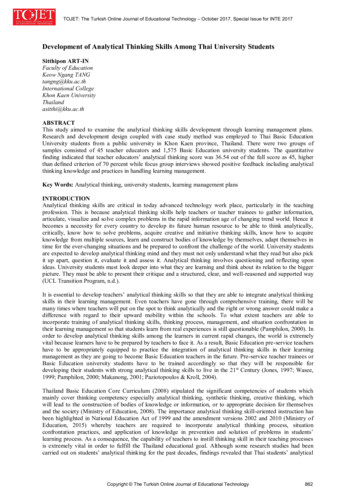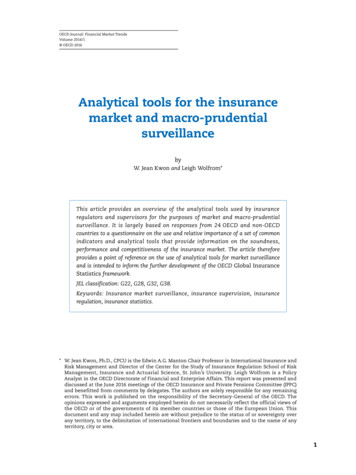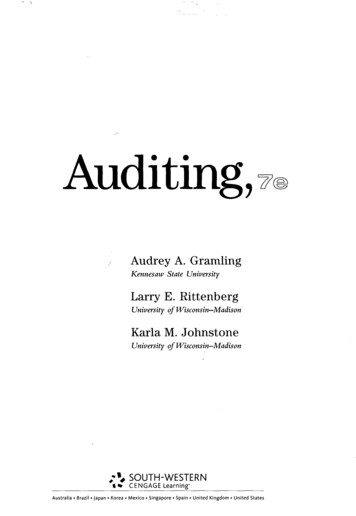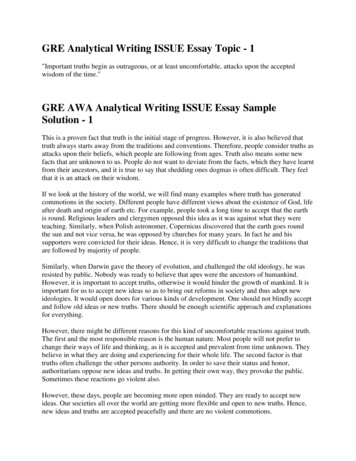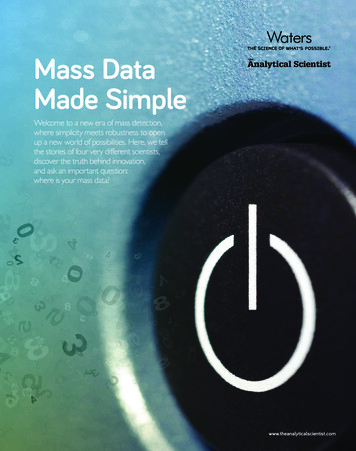
Transcription
Mass DataMade SimpletheAnalytical ScientistWelcome to a new era of mass detection,where simplicity meets robustness to openup a new world of possibilities. Here, we tellthe stories of four very different scientists,discover the truth behind innovation,and ask an important question:where is your mass data?www.theanalyticalscientist.com
C o n te n t s0813160804Ultra Pure ProofPutting robust detection on thefrontlines of method developmentand mass confirmation.By Alex Brien, ReachSeparations, UK.1306Changing the RulesHow simplified detectorscan provide mass data for everyanalytical run and speed upmethod development.With Davy Guillarme, University ofGeneva, SwitzerlandtheAnalytical ScientistTrailblazing a New Kindof InnovationWhat are the challenges whentranslating complexity intosimplicity – and how do wemeasure success in suchan endeavor?With Daniel Kenny, Waters, UKBuilding a PerfectPurification PlatformAdding 90,000 novel candidatesto our compound collection eachyear is challenging. Choosing theright technology is crucial – soit’s great when innovation makesthe decision clear-cut.By Gerard Rosse, DartNeuroScience, California, USA.16Mission Improbable: RapidTotal Sugar ReportingHow mass detection allows us totell the beautiful truth about beer.By Larissa Burns, Lion NSW, Australia.18Methods DevelopmentWorkflows20Increasing Specificity and Sensitivityin Routine Peptide Analyses UsingMass Detection with theACQUITY QDa Detector22Seamless Integration ofMass Detection into the UVChromatographic Workflow
Successful Sideways InnovationThree years on: how far has mass detection come?I n t r o d u c t io nBack in 2013, the ACQUITY QDa Detectorwas awarded a top spot in the inaugur alTASIAs – The Analytical Scientist InnovationAwards. Launched just months earlier byWaters, the ACQUITY QDa immediately caught theattention of the independent judging panel; one judgenoted: “[The QDa] turns MS into a regular detector thatcan be operated by all users. Important improvement interms of reliability of the analysis.” Unlike many of the otherinnovations in 2013, the ACQUITY QDa had a specialquality: the focus was on simplicity and robustness ratherthan scoring points for being more sensitive, more accurateor more complex. The ACQUITY QDa falls into a directionof development that I like to call “sideways innovation,”where the primary aim is to increase usability and adoption.The Analytical Scientist Innovation Awards always focuson the “potential impact” of the product. The Watersnomination read: “Armed with MS data, separationsscientists can be more valuable and more confidentcontributors to the laboratory. The ACQUITY QDaDetector answers many of their questions: Did I synthesizewhat I intended to and how do I know? Is this peak reallypure? Have I accounted for all components in my sample?What is the component represented by this peak? Will mymethod pass validation? The result: greater productivity.”Just how accurate was this statement? Well, over thelast few months I’ve been speaking with QDa users whohave been directly impacted by the innovation introducedexactly three years ago. And it’s fair to say the visionwithin the nomination was prophetic; the ACQUITYQDa has been Waters’ fastest selling MS product to date.However, as Director of MS Development Daniel Kennynotes on page 8, “. Many users will simply see it as ‘justanother detector,’ which I think is fantastic.” In other words,mission accomplished.Within the pages of this compendium, four ACQUITYQDa users share their diverse stories, from speeding upmethod development to building a perfect purificationplatform to reporting low sugar levels in Australian beer.What do all the stories share in common? The ease withwhich mass detection was integrated into each workflow.Is there a market for mass spectrometry with push-buttonsimplicity? Absolutely.Rich WhitworthEditorwww.waters.com/qda
4 S p o ns o r e d S up p l e m e n tUltra Pure ProofPutting robust detection onthe frontlines of methoddevelopment and massconfirmation.By Alex BrienBefore joining the newly formed ReachSeparations in February 2012, I spentfive years at AstraZeneca in analysisand purification (latterly as group leadin reversed phase and chiral purification).This experience gives me a goodperspective of both the needs of ‘bigpharma’ and, more recently, the needs ofa specialist separation solution provider.My time at AstraZeneca allowed meto get ‘hands on’ with a number ofchromatography and mass spectrometryplatforms, and provided me with an acuteawareness of the need for reliable dataand robust instrumentation – somethingthat was reinforced when I joinedReach Separations.Reach Separations started out of theblocks very fast, in part because we hadthe expertise to address enantiomerseparation challenges faced by thepharmaceutical industry in light of tighterregulations; indeed, we started outprimarily as a chiral chromatographyfocused business, serving the pharmamarket. However, over the last four years,we’ve branched out into agrochemicaland fine chemical markets and, as we’vegrown, achiral work has become a muchbigger part of our business.Key analyticsIn addition to our chiral purification work(we tackle everything from mg to kgscale), we offer achiral purification servicesto produce ‘ultra pure’ material that goesonto later stage testing. We also workwith manufacturers at the opposite endof the spectrum, by offering isolation andtheAnalytical Scientistidentification of impurities.When it comes to purification, the mostimportant (and challenging) aspect is theanalysis. From a separations standpoint,we use several UPLC systems and wealso have an SFC equivalent – the WatersACQUITY UPC2. Those two separationsystems are now coupled with a WatersACQUITY QDa mass detector and thisallows us to cover any project that comesinto the laboratory.We’ve had the QDa for 18 months –with only one preventive maintenanceand zero downtime. The investmentcoincided with a sudden surge in companygrowth, and the need to expand ourmass detection capability. Prior to that,we had been working with legacy singlequad mass spec systems that sufferedfrom reliability as well as compatibilityissues. The QDa was an obvious fit,ticking several important boxes for ourlab. Firstly, it’s competitively priced – anysmall but fast-growing lab will appreciatethis parameter; consequently, return oninvestment is near unbeatable. Secondly,compatibility with our UPLC and UPC2systems was assured. Thirdly, becausewe were growing rapidly, lab space wasat a premium, which is where the QDawins hands down – its small footprint iswhat makes it feel more like a detectorthan an MS system, and it fits neatly inwith the other modules. Of course, it alsoneeds to be able to do the job – andwe wouldn’t invest in a system that givesresults that are not comparable to otherservice providers in our space. Mass dataquality from the QDa is excellent for ourneeds and provides us with 100 percentconfidence in all our results.Headache-free mass detectionPossibly the biggest plus point for theQDa is its usability. As we ramped upthe business, we needed additional staffmembers. Rather than wasting preciousresources on training fresh talent on thenuances of quirky, old MS systems, we“I think it’s the firsttime I’ve felt thatmass detection hastruly integrateditself with the restof the separationworkflow.”could get them up and running with ease.Indeed, the new members of our teamwere quickly able to apply theoreticalknowledge of mass spectrometry to reallife samples, which reflects my opinionthat the ACQUITY QDa is one of themost user-friendly pieces of equipmenton the market. Even so, if you’re running ateam of analysts with different experiencelevels, it’s great to be able to confidentlyrely on the ACQUITY QDa’s internalcalibration, which significantly reducesthe potential for operator error. In acompetitive contract environment, gettinganalyses right first time is essential.Even as an experienced user of massspectrometry, the ACQUITY QDa’susability is very welcome. I think it’s thefirst time I’ve felt that mass detection hastruly integrated itself with the rest of theseparation workflow. Companies thatdon’t have mass spectrometry ‘super users’on staff finally have a way to access qualitymass data with confidence. The simple factthat it can be treated like a pump or a UVdetector is a real bonus to our team.On the other side of that coin, you dosometimes have to remind yourself that youare looking at mass spectrometry data. Aneasy to use system needs backing up witheasy to use software. Here again, users of theQDa are presented with a software package
“Companies thatdon’t have massspectrometry‘super users’ onstaff finally have away to accessquality mass datawith confidence.”(Waters Empower 3 Chromatography DataSoftware) that allows some of the easiestdata interpretation I’ve seen – anotherhuge plus.It’s not a toyWith a focus on usability and affordability, itmight be tempting to consider the ACQUITYQDa a plaything, and though it is relativelyfun to use, we throw it some serious tasks.For example, we use it for mass confirmationof samples as they enter and leave the lab.We’ve started using it very heavily with theUPC2 system for chiral separation methoddevelopment. We recently introduced ‘chiralpooling,’ which allows us to analyze as manyas six compounds in a single run to assessoptimal conditions for separating isomers(1). Without mass data, this would not bepossible – we’ve estimated that we arerunning five times faster (55 samples a day)than if we used conventional, sequential SFCruns with UV detection alone. Any piece oftechnology that enables higher throughputis always welcome in a service environment.Today, UPLC, UPC2 and QDa massdetection is our frontline analytical platform.Over the next 12 months, as we continueto grow, I can expect to see us scaling upthat platform, including several more QDadetectors. We feel it puts us in a greatposition to serve our customers with topquality but very competitive analytical andpurification services.If, like me, you’ve worked with (andbeen frustrated by) legacy single-quadMS systems in the past, you’ll likelybe surprised and delighted in equalmeasure by the ACQUITY QDa’ssimplicity and robustness. If you’re newto mass detection, you’ll have to settlefor delighted.Alex Brien is Senior Purification Scientist atReach Separations, library/docs/720005792en.pdfwww.waters.com/qda
6 S p o ns o r e d S up p l e m e n tChangingthe RulesHow simplified detectors canprovide mass data for everyanalytical run and speed upmethod development.With access to multiple mass spectrometrysystems of varying degrees of sophistication,Davy Guillarme (University of Geneva,Switzerland) wasn’t actively looking for newmass detection solutions. Nevertheless, theWaters ACQUITY QDa mass detectorcaught his eye. Why? Because it opens a newdoor to mass spectral data. Here, Guillarme– a chromatography specialist – explains whysimple but robust mass detection has foundan important role in method developmentin his world: pharmaceutical analysis.What are your analytical goals?My field of expertise is liquid chromatography(LC), supercritical fluid chromatography(SFC) and their hyphenation with severaldetectors, including UV, UV-DAD, ELSD,fluorescence, MS, MS/MS and highresolution (HR)MS. Our laboratory isparticularly interested in investigatingmodern LC and SFC technologies; forexample, the use of advanced columns(sub-2µm porous particles or sub-3µmsuperficially porous particles) in conjunctionwith chromatographic systems at veryhigh pressures. Our overarching goal isto develop ultra-fast and/or very highresolution separations for pharmaceuticalsamples of varying levels of complexity –and that means the analysis of small and verylarge molecules in simple pharmaceuticalformulations, but also in biological fluids(using suitable sample preparation).What are the analytical challenges yourlab faces?A few years ago, one of the main constraintswas the limited acquisition speed of masstheAnalytical Scientistspectrometers, when combined withUHPLC. The problem has now beenlargely resolved; most MS systems are nowable to meet the requirements of fast LC.We now face two more practicalchallenges when it comes to acquiringmass data:the inherent complexity of MSinstruments (particularly critical fortechnicians and interns);ii. the cost (both in terms of initialpurchase and ongoing maintenance).i.Another challenge, which emphasizes therapid development in mass spectrometry,is the fact that MS systems can becomeobsolete after only a few years. Newmodels are released so regularly that it’sdifficult to stay at the cutting edge when itcomes to sensitivity in a given application.What MS systems do you have atyour disposal?We have several MS systems from differentmanufacturers, including two singlequadrupoles, two triple quadrupoles, oneTOF-MS, one QTOF/MS and one Orbitrap.Depending on the application (targeted oruntargeted) and the required sensitivity, wehave the ability to hyphenate different inletinstruments (capillary electrophoresis, LCor SFC) to these MS platforms.What motivated you seekother solutions?The MS systems in our laboratory aresomewhat expensive to operate and notalways convenient or easy to use, whichmeans they tend to be devoted to projectsthat deal with the analysis of complexmatrices (for example, urine, blood, plasma,cerebrospinal fluid, and plant extracts).The significant operating costs (and thehigh demand for the MS instruments) haveprevented us from using mass spectrometryto speed up method development inchromatography – even though it’sknown to be a very powerful tool. Overthe last few years, we have used variouscommercial software packages, includinga peak match tool, for peak tracking basedon UV absorbance, for successful HPLCmethod development. However, basedon our experience, we believed that themethod development process could befaster and that the confidence in our resultswould be increased with the help of massdetection. To that end, the launch of theQDa – a simple, relatively sensitive, lowcost mass detector, which was compatiblewith our Empower chromatographicsoftware – caught my eye.Notably, high-powered MS instrumentsare not always needed. Sometimes, avery simple mass detector can have a realimpact in the laboratory when it comes tomethod development, which is now oneof the main roles of our QDa instrument.How does QDa fit into yourcurrent workflows?QDa is based on proven technology– the novelty of this system lies in itsminiaturized format, as well as the fact“In my opinion,the simplicity ofthe QDa iscomparable withspectroscopicdetectors, so caneven be used bypeople with verylimited MSbackgrounds”
M as s D a t a M a d e Sim p l e 7that it is easy to use. In our laboratory, theQDa is used for both service and researchprojects; for example:iii. faster HPLC/SFC methoddevelopment, using MS peak tracking;iv. identification of impurities producedduring chemical synthesis or in acommercial pharmaceutical product;v. the analysis of small molecularweight compounds in relativelysimple matrixes – especially whenUV sensitivity is not sufficientor compounds do not possesschromophores.In our UHPLC-UV-QDa set-up, a dilutionpump with a splitter is included betweenthe UV and QDa detectors to attainconcentration levels that are compatiblewith both detectors. In general, the QDais around 100 times more sensitive than aUV detector (though this factor stronglydepends on the chemical nature of theanalyzed compounds); by using this setup, the signal of both detectors can berecorded at the same time.How would you assess the QDa from alaboratory management standpoint?From an economic point of view, the QDais extremely attractive, as the purchase andoperating costs are significantly lower thanany other MS instrument on the market.In terms of lab efficiency, the QDa isextremely easy to use and controlled byEmpower – a widely used chromatographicpackage, which means that technicians andinterns can be trained to use the QDain less than one day! In my opinion, thesimplicity of the QDa is comparable withspectroscopic detectors, so can evenbe used by people with very limited MSbackgrounds. Thanks to these positivefeatures, we are now able to use massdetection for more applications, improvingconfidence in our results and increasing theamount of information that can be gainedfrom a single injection.Bench space in most laboratories is at apremium – but because the QDa is fullyintegrated with the UHPLC instrument, itdoesn’t take up additional space.Another surprising advantage of theQDa mass detector has to do withcomfort. The primary pumps of other MSinstruments are noisy and typically run24/7, making laboratory environmentstiring. The QDa (and its primary pump)can easily be switched off when not in use,which is a clear advantage. After turningthe instrument on, only a few minutes areneeded before the system can analyzesamples. And because the primary pumpis much smaller than other MS devices, thenoise remains reasonable even when theQDa is in use.Will robust, simplified systems changehow mass detection is adopted?Many laboratories could benefit fromthe excellent sensitivity, high selectivityand mass information provided bymass spectrometry, which perfectlycomplements chromatographic methods.However, as noted above, such MSinstruments are not always available, eitherbecause of the associated cost or a lackof highly qualified technicians. The QDachanges the rules. It has been specificallydesigned for chromatographers and not formass spectroscopists – and it makes massdetection much more affordable.Where do you see the future of massdetection in your field?Mass detection is extremely useful inanalytical chemistry and will certainlycontinue to develop at a rapid pace. I seetwo different trends in the MS market. Onthe one hand, many providers will continueto offer MS instruments with increasinglyhigh performance; such state-of-theart instruments are obviously dedicatedto mass spectroscopists, with specifictraining and expertise. For this category ofinstruments, I suspect that IMS-MS will bemore and more widely used in the future.On the other hand, there is a cleardrive towards making mass data moreaccessible to non-mass spectroscopists (forexample, chromatographers). Here, lowercost, simplified operation, reduced size,and reduced maintenance are the mostimportant factors. In the future, I expect –and would like to see – other types of massanalyzer enter into this second category,including triple quadrupole and time-offlight instruments.www.waters.com/qda
8 S p o ns o r e d S up p l e m e n tTrailblazing a NewKind of InnovationWhat are the challenges whentranslating complexity intosimplicity – and how do wemeasure success in such anendeavor? Daniel Kenny, Directorof MS Development at Waters,shares the motivation, inspirationand celebration behind thedevelopment of the ACQUITYQDa Detector.What was the starting point forthe ACQUITY QDa Detector?We believe in the power of massspectrometry – what it can do andwhat it can deliver. So we started byconsidering what barriers were preventingpeople from adopting MS technology –affordability and footprint came into play,but the big focus was on the question:“Why is mass spectrometry seen asbeing scary?” We knew that we neededto address the complexity behind massspectrometry for our customers, which iswhy accessibility and usability are integralto the design of the ACQUITY QDa.Most people will be aware of ‘tripleconstraint’ triangles – but we wereworking with a square, needing to balanceusability/robustness, miniaturization, cost,and also performance. For example, withthe source, instead of trying to achieveultimate performance for any onecompound or any one assay, we focusedon ensuring good quality data for mostanalyses, most of the time by simplifyingthe design. Minimizing the degree ofcompromise on any one corner of oursquare required serious innovation.Is that why the concept-to-producttimeline was longer than usual?The ACQUITY QDa is an absoluteground-up redesign of a masstheAnalytical Scientistspectrometer. Typically, new instrumentscome about through evolution –‘borrowing’ several components froman existing product while introducing anew innovation that boosts sensitivity,for example. You don’t normally have toreinvent absolutely everything for a newinstrument – especially when you alreadyhave components that are fit for purpose.However, this was not the case with theQDa. I believe it was over four years fromfirst informal discussions to finally puttingthe instrument in our customers’ hands.Within that time, the ‘engineering model’phase was essential, allowing us to make –and learn – from mistakes as we focusedon miniaturizing and simplifying variousaspects of the evolving design.Could you share some examples of“ground-up” design in the QDa?We filed numerous patent applicationsfor inventions related to the ACQUITYQDa – and not the sort of patents thatwe have historically filed (which tendto be focused on performance – newways of manipulating ions, getting moresensitivity, and so on). A good exampleis the electrospray probe – somethingthat a user will almost certainly have tointeract with at some point, because thecapillaries within can become blocked ordeteriorate over time. We wanted tomake maintenance as painless as possible(it takes quite a bit of a skill to dismantle atypical probe and fit a new capillary) andthat led to a very different probe design.The probe is an all-in-one component,with the capillary already crimped to thePEEK tube that will connect to the columnor UV detector. You can literally swap thewhole probe in a matter of seconds ratherthan taking up to an hour to do so. And,perhaps more importantly, the processis more reproducible, which ensuresconsistent performance that does notrely upon on user aptitude. An all-in-onedesign also allows us to minimize deadvolume – another benefit to the user.
Early ACQUITY QDa Detector engineering prototypeAnother aspect of usability is robustness.We’ve built the QDa detector assomething that is going to be used day in,day out – perhaps by someone who maynot have worked with mass spectrometrybefore. To that end, we assumed thatusers were either not accustomed to –or simply did not enjoy – cleaning thesampling orifice or cone as they wouldhave to do in a typical electrospray MSsystem. So instead of having a very smallsampling aperture at the apex of thetheAnalytical Scientistsample cone, we decided to hide theaperture down a tunnel that protects itfrom spray that would lead to chargingproblems over time. And with cost also inmind, we engineered a solution that wasinexpensive and so easy to replace thata novice can do it with confidence. Thecomponent is effectively disposable; whenit becomes dirty or blocked, you vent theinstrument, throw the orifice in the trashand insert a new one. And because thepumping volume of the ACQUITY QDais very small, you can be up and runningagain in another ten minutes.Going back to the electrospray source,in traditional mass spectrometry we havealmost infinite flexibility – we can movethe probe up and down, left and right,we can move the capillary within theprobe, we can change the gas flow, thetemperature, entrance voltages. All thevariables allow us to optimize performancefor a given analytical need – but they alsoadd a great degree of complexity. In the
M as s D a t a M a d e Sim p l e 11Reverse cone geometry evolutionWe applied the same rules to thesoftware – we wanted to maximizeusability and create something that willbe familiar to chromatographers. To thatend we locked down certain parametersand automated complex tasks. But there’sa lot going on ‘behind the scenes’, withmany ‘advanced’ (but little-used) settingshidden from view and set to optimaldefaults. We also looked very closely atthe software interfaces we had in placefor other LC detectors, and tried as bestwe could to use the same language andterminology. We wanted interaction withthe ACQUITY QDa to be highly familiarwith chromatographers coming from aUV or PDA detector background.ACQUITY QDa, we reduced complexity(and therefore flexibility) by designing acompletely pre-optimized geometry withfixed gas flows and so on. The result: itjust works.Many other engineering solutionsand innovations came into play duringdevelopment to bring the push-buttonsimplicity and footprint of the QDa Detector.Clearly, there was a lot of hardwareinnovation – what about software?Was everyone involved as passionateabout the project as you?It was one of those great times when wehad great deal of ‘buy in’ – everybodyunderstood the concept and was fullyfocused on delivering it. It really wasa massive team effort – it took theefforts of hundreds of people to makethe ACQUITY QDa happen. Withoutthe passion and determination, I don’tthink we could have achieved what weset out to do: create an extremely user-“The QDa isactually our fastestselling massspectrometryproduct – butmany users will justsee it as ‘simplyanother detector,’which I think isfantastic. It meanswe’ve succeeded!”friendly mass detector with appropriateperformance at the right cost – and in aformat that fits into a regular HPLC stack.Why has it taken so long for a massdetector like the ACQUITY QDa?I suspect there have been severalwww.waters.com/qda
12 S p o ns o r e d S up p l e m e n tACQUITY QDa Sample Cone Robustness.“The developmentof the QDa – andthe response thatit’s received – hasemboldened us; wenow realize thatultimate usability issomething that istruly valued.”attempts before – but they probablystrayed away from the original conceptand core objective. Sometimes it seemssafer to ‘hedge your bets’ and end upwith a product that is too far removedfrom the initial remit. We were braveenough to maintain the clarity around ouroriginal vision right through to productiontheAnalytical Scientist– and I guess that’s quite unusual in aperformance-obsessed industry. Bychoosing instead to focus on ease of use,size and cost – and accepting that somecustomers don’t need the highest levelsof sensitivity or the widest possible massrange – we’ve found success where othershave failed, by opening up mass detectionto a new audience.The development of the ACQUITY QDa– and the response that it’s received (bothinternally and externally) – has emboldenedus; we now realize that ultimate usabilityis something that is truly valued. We’verecognized that we can successfully movein a new direction of innovation and I amsure that will be reflected in productsthat we commercialize in the future.Waters has always driven by performance(and we see ourselves as ahead of thetechnology curve in the marketplace) –now, we will also be driven by the needto provide a well-rounded experience forour customers.The ACQUITY QDa is actually ourfastest-selling mass spectrometry product– but many users will simply see it as ‘justanother detector,’ which I think is fantastic. Itmeans we’ve succeeded! We never wantedto supplant UV detection, which is still agold standard for many things, rather wewanted to supplement UV with additionalvaluable information that was previously outof reach. Witnessing the uptake of QDa,and seeing customers benefit from whatwe have achieved is immensely satisfying.Disruptive products tend to spursurprise applications – has anythingcaught your eye?In the beginning and through development,we were aiming the ACQUITY QDasquarely at (liquid) chromatographers –and so yes, some applications have beenunexpected and also very interesting. Forexample, we’ve heard of QDa detectorsbeing wheeled around on laboratorytrolleys to take the analysis to the sample– others are being used in fume-hoodsto monitor reactions. And we literallyput one into a rucksack and carried itto the top of a mountain to do analysiswith a special prototype probe. Manyof these exciting applications are ‘pointof-use’ direct analyses that simply takeadvantage of being able to do somethingnew. And that’s perhaps more satisfyingthan anything else.
M as s D a t a M a d e Sim p l eBuilding a PerfectPurificationPlatformAdding 90,000 novel candidatesto our compound collection eachyear is challenging. Choosing theright technology is crucial – soit’s great when innovation makesthe decision clear-cut.By Gerard RosseDart NeuroScience is one of the largestprivately owned biotech companies inSan Diego with around 250 employees– and we have an interesting focus:memory. More specifically, our aim is todevelop new technologies and therapiesthat can maintain or improve memoryfunction and cognitive vitality.Much of our research is built onthe work of Tim Tully, who was aprofessor and Head of the Division ofNeurogenetics at Cold Spring HarborLaboratory in New York before foundingDart NeuroScience – he’s now ourExecutive Vice President of R&D andChief Scientific Officer. In brief, Tullydiscovered the important role that theCREB gene plays in the formation of longterm memory; our target compoundsaim to modulate that CREB pathway.Curating a compound collectionI’ve worked in the pharmaceuticalindustry for more than 15 years – startingat Hoffmann-La Roche in Switzerlandbefore moving over to the US to joinSanofi-Aventis and then Cephalon/Teva. I joined Dar t NeuroSciencein 2011 to help build the StructureGuided Chemistry department – anessential component of our ambitiousprogram. My group has a very specificmission: to develop novel technologiesand chemistries to create a proprietaryand prospective compound collectiondesigned from 3D surface features ofproteins. When I joined the company,my first job was to build a technologyplatform for the automated synthesis,purification and analysis of compounds. 13Our aim is to add 90,000 compounds tothe collection each year, so it’s certainlya large-scale project with a number ofchallenges. Our laboratory looks l
Waters, the ACQUITY QDa immediately caught the attention of the independent judging panel; one judge noted: "[The QDa] turns MS into a regular detector that can be operated by all users. Important improvement in terms of reliability of the analysis." Unlike many of the other innovations in 2013, the ACQUITY QDa had a special


